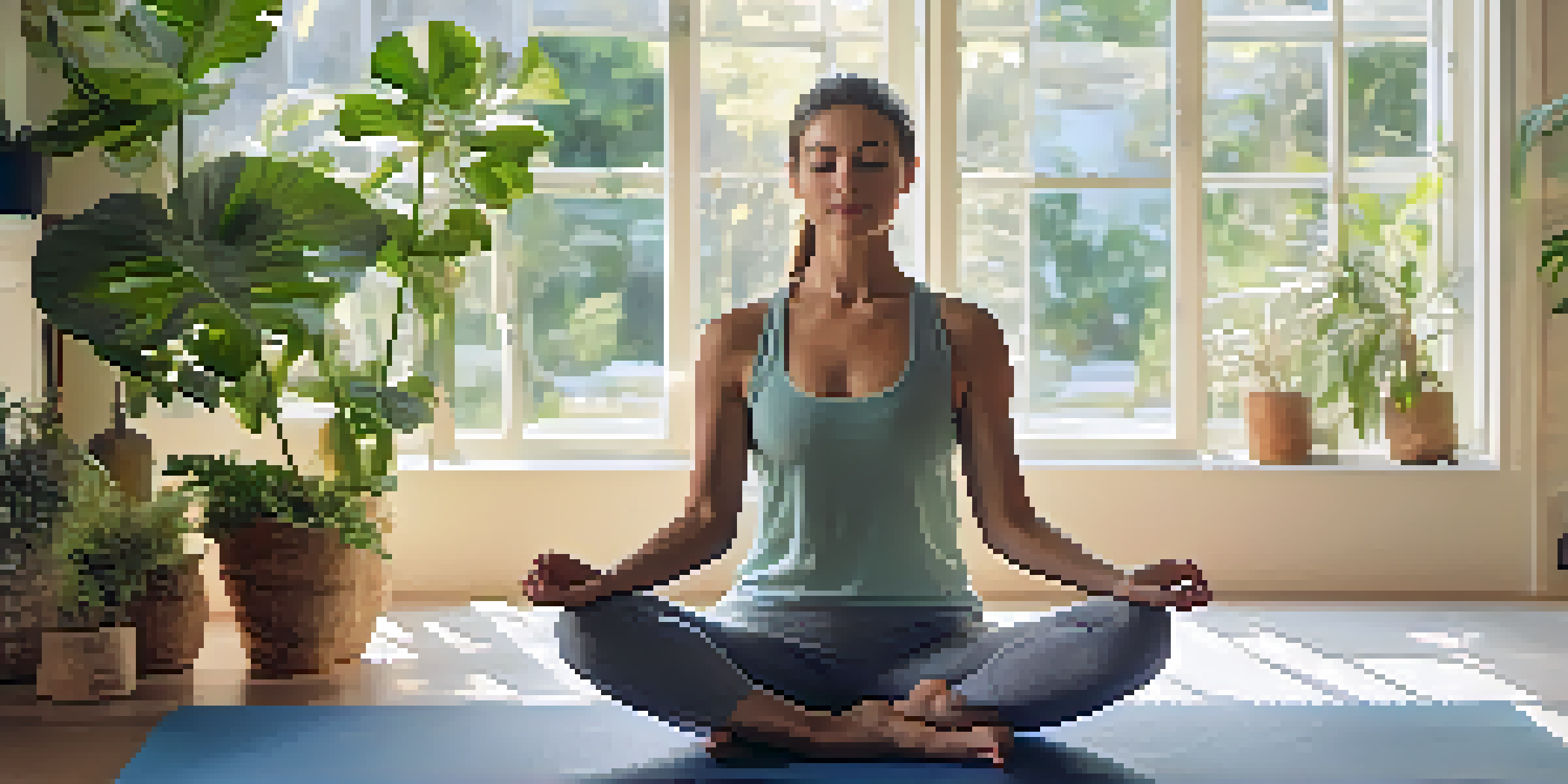How Breath Control Enhances Focus During Yoga Sessions

Understanding Breath Control in Yoga Practice
Breath control, or pranayama, is a fundamental aspect of yoga that involves regulating your breath to enhance physical and mental well-being. By mastering your breath, you can cultivate a deeper connection to your body and mind. This practice is not just about inhaling and exhaling; it’s about harnessing your breath to create calmness and clarity.
The breath is the bridge which connects life to consciousness, which unites your body to your thoughts.
During yoga sessions, breath control allows practitioners to synchronize their movements with their breath, creating a fluid and harmonious experience. This synchronization helps to anchor the mind, making it easier to focus on the present moment. As you breathe deeply and rhythmically, you create a steady foundation for your practice, reducing distractions.
Moreover, breath control serves as a bridge between the mind and body. When you control your breath, you can influence your heart rate and reduce feelings of anxiety, making it easier to concentrate on your poses. This connection is essential for enhancing focus, allowing you to immerse yourself fully in your yoga practice.
The Science Behind Breath and Focus
Research has shown that controlled breathing can significantly affect our cognitive functions. When we practice breath control, we stimulate the parasympathetic nervous system, which promotes relaxation and reduces stress. This physiological response helps to clear mental clutter, paving the way for improved concentration.

One fascinating study found that participants who engaged in breath control exercises exhibited better attention and memory performance compared to those who did not. This highlights how breath control is not merely a yoga technique but a powerful tool for enhancing cognitive abilities. By focusing on your breath, you can sharpen your mental faculties during yoga and beyond.
Breath Control Enhances Yoga Practice
Mastering breath control improves physical performance, mental clarity, and emotional balance during yoga.
Additionally, the act of focusing on your breath can create a meditative state, which is known to improve overall mental clarity. This state of mindfulness can help practitioners maintain focus on their poses and movements during their sessions, allowing for a more enriching experience. It’s a simple yet profound way to enhance your practice.
Techniques for Effective Breath Control
To integrate breath control into your yoga sessions, start with simple techniques like diaphragmatic breathing. This involves breathing deeply into your diaphragm rather than your chest, allowing for fuller breaths that promote relaxation. Practicing this technique can enhance your lung capacity and improve your overall breath control.
When you own your breath, nobody can steal your peace.
Another effective method is the 4-7-8 technique, which involves inhaling for four counts, holding for seven, and exhaling for eight. This exercise not only calms your mind but also helps build focus over time. By incorporating these techniques into your practice, you’ll find it easier to maintain concentration during challenging poses.
Lastly, consider implementing breath counts with your movements. For example, you might inhale as you raise your arms and exhale as you lower them. This rhythmic breathing creates a flow that can help you stay engaged and focused throughout your yoga practice. It turns your routine into a mindful journey.
Building Mindfulness Through Breath Control
Mindfulness is about being present and aware of your thoughts and feelings, and breath control is a key element in fostering this state. When you focus on your breath, you naturally draw your attention away from distractions and into the moment. This shift is crucial for cultivating mindfulness in your yoga practice.
By paying attention to your breath, you can observe your thoughts without judgment, allowing you to let go of any mental chatter. This practice encourages a sense of acceptance, enabling you to focus on your body and movements during yoga. As a result, you’ll find it easier to engage with your practice more fully.
Mindfulness Through Focused Breathing
Focusing on your breath fosters mindfulness, allowing practitioners to stay present and engaged in their yoga sessions.
Furthermore, mindfulness through breath control can extend beyond your yoga mat. The skills you develop during your sessions can be applied to daily life, helping you stay focused and centered even in challenging situations. Ultimately, breath control fosters a deeper sense of awareness that enhances your overall well-being.
Enhancing Physical Performance with Breath
Effective breath control can directly enhance your physical performance during yoga sessions. When you breathe deeply and rhythmically, you provide your body with adequate oxygen, which is necessary for sustaining energy levels. This means you can hold poses longer and with more stability.
Additionally, proper breathing techniques can help you manage fatigue. By focusing on your breath, you can reduce tension in your body and maintain a sense of calm, which is essential for executing challenging poses. This ability to manage fatigue can significantly improve your overall performance and enjoyment of yoga.
Moreover, breath control aids in better alignment and posture. When you consciously breathe into specific areas of your body, you can create space and ease tension, allowing for a greater range of motion. This not only enhances your practice but also helps prevent injuries, making breath control an essential component of physical performance.
Fostering Emotional Balance with Breath Control
Breath control also plays a significant role in emotional regulation. Many people experience heightened emotions during yoga, and controlling your breath can help you navigate these feelings more effectively. By focusing on your breathing, you can create a calming effect that allows you to process emotions without becoming overwhelmed.
This emotional balance can lead to a more fulfilling yoga experience. As you learn to manage your emotions through breath control, you may find yourself more connected to the practice and to yourself. This connection can lead to greater self-awareness and acceptance, enhancing your overall emotional well-being.
Effective Techniques for Better Breathing
Incorporating techniques like diaphragmatic breathing and the 4-7-8 method can significantly enhance your breath control.
Moreover, breath control can serve as a tool for grounding yourself during difficult moments in your practice. When you encounter a challenging pose or emotion, returning to your breath can provide a sense of stability and reassurance. This practice of grounding can be transformative, helping you cultivate resilience both on and off the mat.
Incorporating Breath Control into Your Routine
To fully experience the benefits of breath control in your yoga practice, it's essential to make it a regular part of your routine. Start by dedicating a few minutes before and after your sessions to focus solely on your breath. This intentional practice will help you establish a deeper connection between your breath and movements.
You might also consider integrating breath control techniques into your daily activities. Whether it’s during a stressful workday or a busy commute, take a moment to focus on your breath. This practice can serve as a reminder to stay present and focused, enhancing your overall mindfulness throughout the day.

Lastly, don’t hesitate to explore different breath control techniques. Each individual may find certain methods more beneficial than others. Experimenting with various techniques can help you discover what works best for you, making your yoga practice even more rewarding.